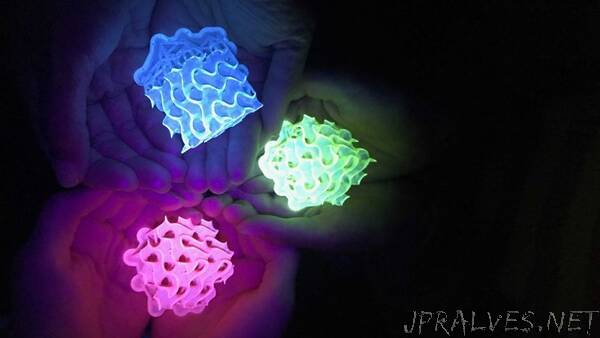
“Fluoro highlighters, glow-in-the-dark paints or even high-viz witch’s hats are bright, but they are nothing compared to these balls.
Scientists in the US and Denmark have created the brightest-known fluorescent materials in existence, by figuring out a reliable way to make fluorescent solids.
This discovery, published today in the journal Chem, could have potential applications in everything from solar energy to medical diagnostics and lasers, to perhaps even autonomous cars.
While there are more than 100,000 fluorescent dyes that glow when they are in a liquid form, maintaining the brightness of the colours is much trickier in solids.
This is due to a process called fluorescence quenching, said materials chemist Amar Flood of Indiana University, who is one of the senior authors on the study.
Molecules of fluorescent dyes — or fluorophores — in liquids are separated by other chemicals called solvents, whereas in solid form they pack too close together and interfere with each other.
“The molecules need to be ‘socially distanced’,” Professor Flood said.
“The problem is there’s been no universal way that you just can enact it [in solid materials].”
To get around the problem, Professor Flood and his co-authors used a doughnut-shaped molecule known as a cyanostar to separate positively-charged (cationic) fluorescent dye molecules and their counter anions.
The negatively-charged anion sits inside the hollow of the ‘doughnut’ cyanostar and the fluorescent cation sits outside.
In this way the cations and anions are stacked charge upon charge in a chequerboard lattice, like you would see in a crystal lattice of sodium chloride (otherwise known as common salt), so that when the solution solidifies the dye molecules are kept apart.
These lattices are called SMILES or small-molecule ionic isolation lattices.
The crystals are made into powders, and then spun into a thin film or incorporated into a synthetic substance called a polymer.
Size-for-size, the final product is about 30 times brighter than cadmium selenide quantum dots used in medical diagnostics and bioimaging.
What could they be used for?
These bright fluorescent materials could be used to improve solar cells, medical lasers to treat skin blemishes or assist with wound healing, medical diagnostics and 3D displays.
We’re now in a position to make more of these advanced optical materials by design rather than trial and error, Professor Flood said.
“That’s the power of this material.”
A more speculative application could be to help autonomous vehicles work out where they are on the road.
Instead of relying on GPS that could go down, the vehicles could rely on physical information right there at the roadside by sending out light to a material encoded with this fluorescence and getting information back.
Being able to create what the authors say is the brightest-known fluorescent material in existence certainly sounds good, said organic chemist Wallace Wong of the University of Melbourne, who wasn’t involved in the study.
He believes the magic ingredient in the mix is Professor Flood’s doughnut-shaped cyanostar.
“Because [it] is able to sort of capture those anions so well, it can then separate those cationic dye molecules and basically maintain the fluorescent properties of those molecules,” Dr Wong said.
That’s good news if you want the material to fluoresce and adds another tool to toolbox for material scientists working with dyes, he said.”
